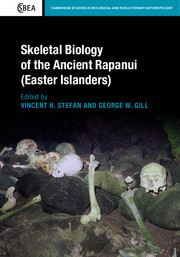Book contents
- Frontmatter
- Contents
- List of contributors
- Acknowledgements
- 1 Introduction: Research overview
- 2 Review of Polynesian and Pacific skeletal biology
- 3 Chronology and Easter Island prehistory
- 4 A descriptive skeletal biology analysis of the ancient Easter Island population
- 5 Craniometric variation of the prehistoric Polynesians and Rapanui
- 6 Rapanui non-metric cranial traits
- 7 Intra-island discrete cranial trait variation
- 8 Continuous non-metric characteristics of the early Rapanui
- 9 Rapanui dental morphology
- 10 Pelvic variability and sexual dimorphism in prehistoric Rapanui
- 11 Genetic affinities of the Rapanui
- 12 Archaeogenetics and paleodemographic estimation of founding populations: Features of residential geography on Rapa Nui
- 13 Evidence for injuries and violent death
- 14 Demographic analysis of modified crania from Rapa Nui
- 15 East Polynesian and Paleoindian parallels and contrasts in skeletal morphology
- 16 Rapanui origins, relationships, and warfare: A summary in theoretical context
- References
- Index
11 - Genetic affinities of the Rapanui
Published online by Cambridge University Press: 05 December 2015
- Frontmatter
- Contents
- List of contributors
- Acknowledgements
- 1 Introduction: Research overview
- 2 Review of Polynesian and Pacific skeletal biology
- 3 Chronology and Easter Island prehistory
- 4 A descriptive skeletal biology analysis of the ancient Easter Island population
- 5 Craniometric variation of the prehistoric Polynesians and Rapanui
- 6 Rapanui non-metric cranial traits
- 7 Intra-island discrete cranial trait variation
- 8 Continuous non-metric characteristics of the early Rapanui
- 9 Rapanui dental morphology
- 10 Pelvic variability and sexual dimorphism in prehistoric Rapanui
- 11 Genetic affinities of the Rapanui
- 12 Archaeogenetics and paleodemographic estimation of founding populations: Features of residential geography on Rapa Nui
- 13 Evidence for injuries and violent death
- 14 Demographic analysis of modified crania from Rapa Nui
- 15 East Polynesian and Paleoindian parallels and contrasts in skeletal morphology
- 16 Rapanui origins, relationships, and warfare: A summary in theoretical context
- References
- Index
Summary
Introduction
The biological origin of the Rapanui is a subject of great interest to anthropologists and historians. While most scholars today agree that Polynesia and Easter Island were colonized by Southeast Asian seafarers associated with the Lapita Cultural Complex, there have been alternative theories, some verging on the fanciful (Bellwood, 1978; Howe, 2003). One well-known view, popularised by the Norwegian explorer Thor Heyerdahl, is that Easter Island was settled by pre-Inca navigators stemming from the region of Lake Titicaca in Peru. Heyerdahl demonstrated the feasibility of a sea voyage from South America to Polynesia in his 1947 Kon-Tiki expedition, from Callao in Peru to Raroia Atoll in the Tuamotus, but his evidence for prehistoric trans-Pacific contacts is largely circumstantial (Heyerdahl, 1950, 1952).
The decline of the Easter Island population started in the Late Period of prehistory and was exacerbated after European contacts. The eventual destruction of much evidence of the prehistoric population, culture, and landscape spurred generations of biologists, anthropologists, and medical researchers to apply all available scientific techniques to the question of the origins and genetic affinities of the early inhabitants. From early on, explorers and scientists collected well-preserved crania from prehistoric burial sites, and these made their way to museums throughout the world. In the modern era, systematic excavations have been carried out, for example during the Norwegian Archaeological Expedition of 1955–56, and the Easter Island Anthropological Expedition of 1981, and complete, well-documented skeletons have been collected and submitted to a wide spectrum of biological studies (Clow et al., 1998; Gill and Owsley, 1993; Murrill, 1965). The results of these studies, together with multivariate craniometric analyses of all cranial samples, have demonstrated the Polynesian affinities of the Easter Island population (Howells, 1973a; Stefan, 2000), and rule out a major Peruvian influence. Yet questions remain on particular details of the origin of the ancient Rapanui, and there is still debate on the extent of the South American contribution to the overall Polynesian population structure and culture of the original Easter Islanders.
The living Rapanui have also been subjected to numerous genetic studies, from blood groups in the early decades of the twentieth century, to high-resolution DNA typing in recent years. Molecular genetic analyses on Pacific populations have provided contradictory evidence of past human trans-Pacific contacts.
- Type
- Chapter
- Information
- Skeletal Biology of the Ancient Rapanui (Easter Islanders) , pp. 182 - 201Publisher: Cambridge University PressPrint publication year: 2016



